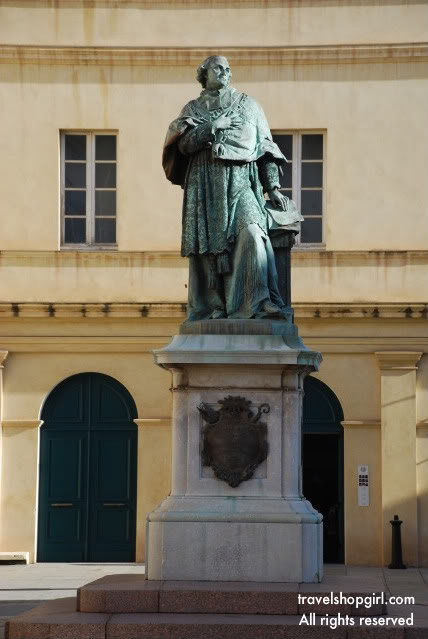
After a fun night onboard the Adventure of the Seas, we were ready for our next port of call: Ajaccio, Corsica. Tourism plays a big part inthe Corsican economy. The island’s climate, mountains and coastlines make it popular among tourists. The island has not had the same level of intensive development as other parts of the Mediterranean and is thus mainly unspoiled.
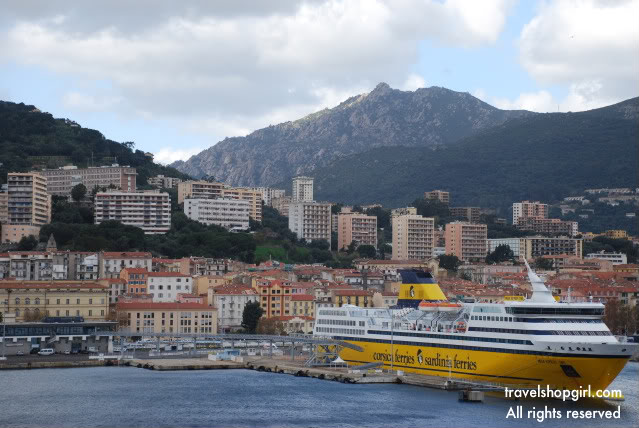
Corsica is an island in the Mediterranean and is located west of Italy, southeast of the French mainland and north of the island of Sardinia.
Corsica is one of the 26 regions of France although it is technically designated as a “territorial collectivity.” Although closer to Italy than to the French mainland, politically Corsica is part of Metropolitan France, but at one point it was an independent Corsican Republic until incorporated into France in 1769. In the 1999 census, 87.1% of the population was French-born with 10% (26,018) being born out of France. The majority of immigrants were from the Maghreb region, particularly Moroccans (41.9% of immigrants) but also Italians (18.7%) and Portuguese (12.3%).
As this is an island and it was November, let me tell you that it was COLD! The entire time I was in Corsica, my eyes were watering from the wind and overall frigid temperatures. Corsica is known as the most mountainous island in the Mediterranean. Corsica is 183 kilometres (114 mi) long at longest, 83 kilometres (52 mi) wide at widest, has 1,000 kilometres (620 mi) of coastline, more than 200 beaches, and is very mountainous, with Monte Cinto as the highest peak at 2,706 metres (8,878 ft) and 20 other summits of more than 2,000 metres (6,600 ft). Mountains comprise two-thirds of the island, forming a single chain. The island is 90 kilometres (56 mi) from Tuscany in Italy and 170 kilometres (110 mi) from the Côte d’Azur in France. It is separated from Sardinia to the south by the Strait of Bonifacio, a minimum of 11 kilometres (6.8 mi) wide.
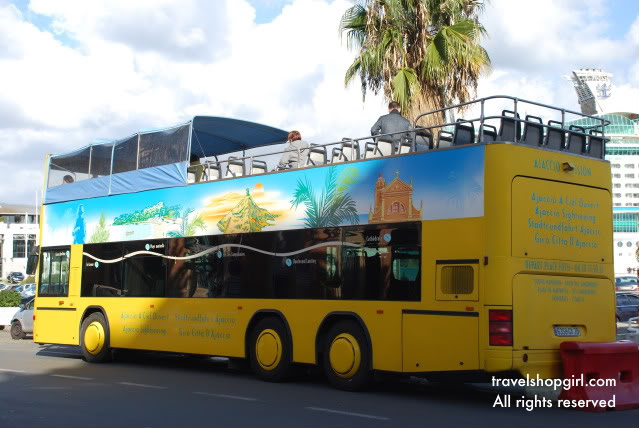
When we disembarked from the ship and headed into Ajaccio, we realized that the easiest way to get around would be if we jumped on a bus. We spotted a hop on/hop off bus nearby, the Ajaccio Sightseeing Tour, and you can see how close it is as the ship is in the background of the picture. A 45 minute tour of the city is only €7 and a 1 hour, 20 minute tour is only €10. The tour is in French and English and if you are traveling during the colder months, you should probably pick a seat inside.

Alternatively, we could have taken Le Petit Train d’Ajaccio around the city, but it looked a little too slow for us and there were more elderly people and families on it than we were interested in at the moment. What I mean is that there were small crying children and some senior citizens, which just wasn’t our idea of fun. The little train isn’t on tracks, but does motor around the city at a reasonable pace.

In Ajaccio you will notice that the city has an abundance of statues everywhere. This one says it is in homage to the resistance of 1940-1945 and for those who gave their lives for a free Corsica and France.

This statue is at first probably seen as simply a tribute to the military, but then you see that the woman to the side is crying while the man is taken away by an angel. Sad and quite gripping at the same time. The placard reads, “La Corse: A ses enfants morts pour la patrie” and the literal translation is “Corsica: The dead children for the fatherland.” Somehow it sounds better in French, but one thing is for sure. They certainly honor those that they have lost who paid for their lives defending their country.

Corsica’s major claim to fame is that Napoléon Bonaparte was born in Ajaccio and evidence that he lived here is at every turn. His ancestral home, Casa Buonaparte, is pictured here.
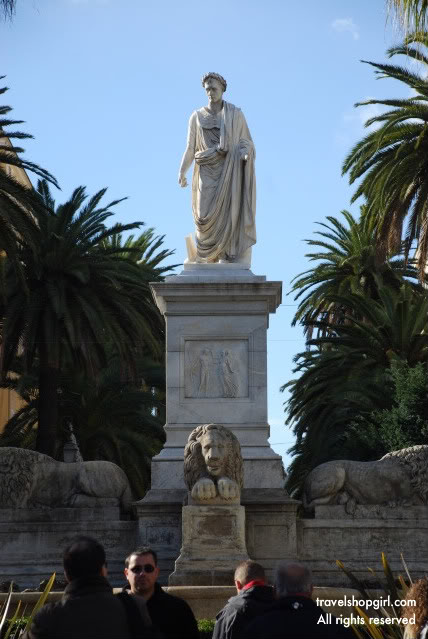
In Place du Général Foch in front of the Fontaine des Quatre Lions stands a marble statue – of Bonaparte as First Consul wearing a Roman toga. The statue was created by Maximilien Laboureur. This statue is close to the port and near the boarding locations of the bus and little train.
Another statue of Napoleon stands in a square by the pedestrian shopping section of Ajaccio. But don’t worry if you miss this one as there are several throughout the area depicting Napoleon in various ways, all favorable to their beloved leader.

The bus tour took us on a ride around Ajaccio and past the Ajaccio cemetery. As is the case in many countries, space in which to bury people is at a premium and so people are not buried below the ground. The cemetery went on for a while and the variety of what was in it from the small buildings to the larger ones were intriguing.

Of course, to go from a solemn picture to one that was right out crazy is nothing new for me. Here we are slowing down in the city and what do we see? A horse drawn carriage with Santa and a few of his friends: Super Mario and Tigger. Who else would be out and about in Corsica with Santa?

When the bus tour ended, we decided to head out on foot for a little shopping. The narrow pedestrian areas offers an abundance of shopping opportunities from souvenirs to clothing to food. How can you pass up fresh pastries?

Remember the hot chocolate my son had in Málaga? He was happy that he was able to find it here in Corsica as well.

You know how I love weird things and this one made me laugh out loud. If you’re not a meat eater like myself, finding places to eat when you’re not at home can sometimes be challenging. So when I spotted a vegetarian item on the menu at Holly Burger, I thought, “Fantastic!” But take a closer look at the menu:
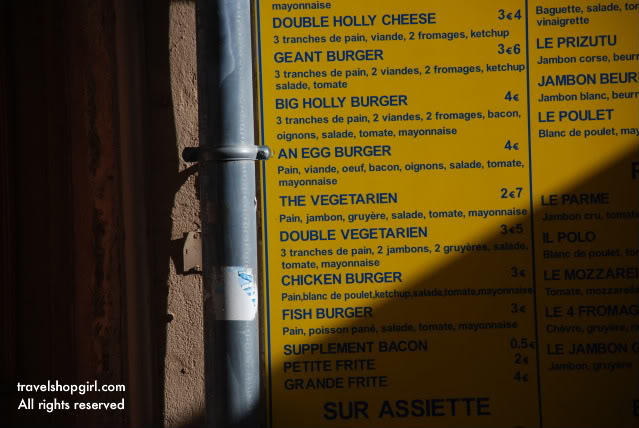
That’s right, The Vegetarien offers diners a sandwich consisting of “pain, jambon, gruyère, salade, tomate, mayonnaise.” In case your high school French is a little rusty , this is what is in the sandwich: bread, ham, Gruyere cheese, lettuce, tomato, and mayonnaise. Last time I checked, ham is not vegetarian! But in case you thought maybe it was just a typo, check out the Double Vegetarien: “3 tranches de pain, 2 jambon, 2 gruyère, salade, tomate, mayonnaise.” Yes, that’s three pieces of bread, two pieces of ham, two pieces of Gruyere cheese, lettuce, tomato, and mayonnaise. Ah yes, gotta love the double ham offering!
One of the images we saw repeatedly was the Corsican flag and how incredibly proud Corsicans are of the image on it that you see it just about everywhere.
The Flag of Corsica was adopted by General of the Nation Pasquale di Paoli in 1755 and was based on a traditional flag used previously. It portrays a Moor’s Head in black wearing a white bandana above his eyes on a white background. Previously, the bandana covered his eyes; Paoli wanted the bandana moved to above the eyes to symbolise the liberation of the Corsican people.
It was used by the ill-fated Corsican Republic and was practically banned after 1769, when France bought the island to settle a Genoese debt and put down the endemic rebellion on the island. During this period under French rule, 1769–1789, Corsican patriots again used the version of the flag with blindfolded eyes, as a mark of protest.
The unblindfolded version, quartered with the British coat of arms, was used as the official flag during the Anglo-Corsican Kingdom of 1794-1796. It then fell into official disuse until 1980, when it was re-adopted as a regional flag.
The Moor’s Head is also used on the Coat of Arms of Corsica.
Here you see it in use in a sign for a restaurant:

By the time we arrived back by the ship, we were done. Between walking around and shopping and freezing on the double decker bus, I was looking forward to thawing out in our cabin or at least in one of the bars with a drink. I would love to go back to Ajaccio, but next time I will demand some warm weather!
Up next: Toulon (Provence), France so polish off your French dictionary kids!




